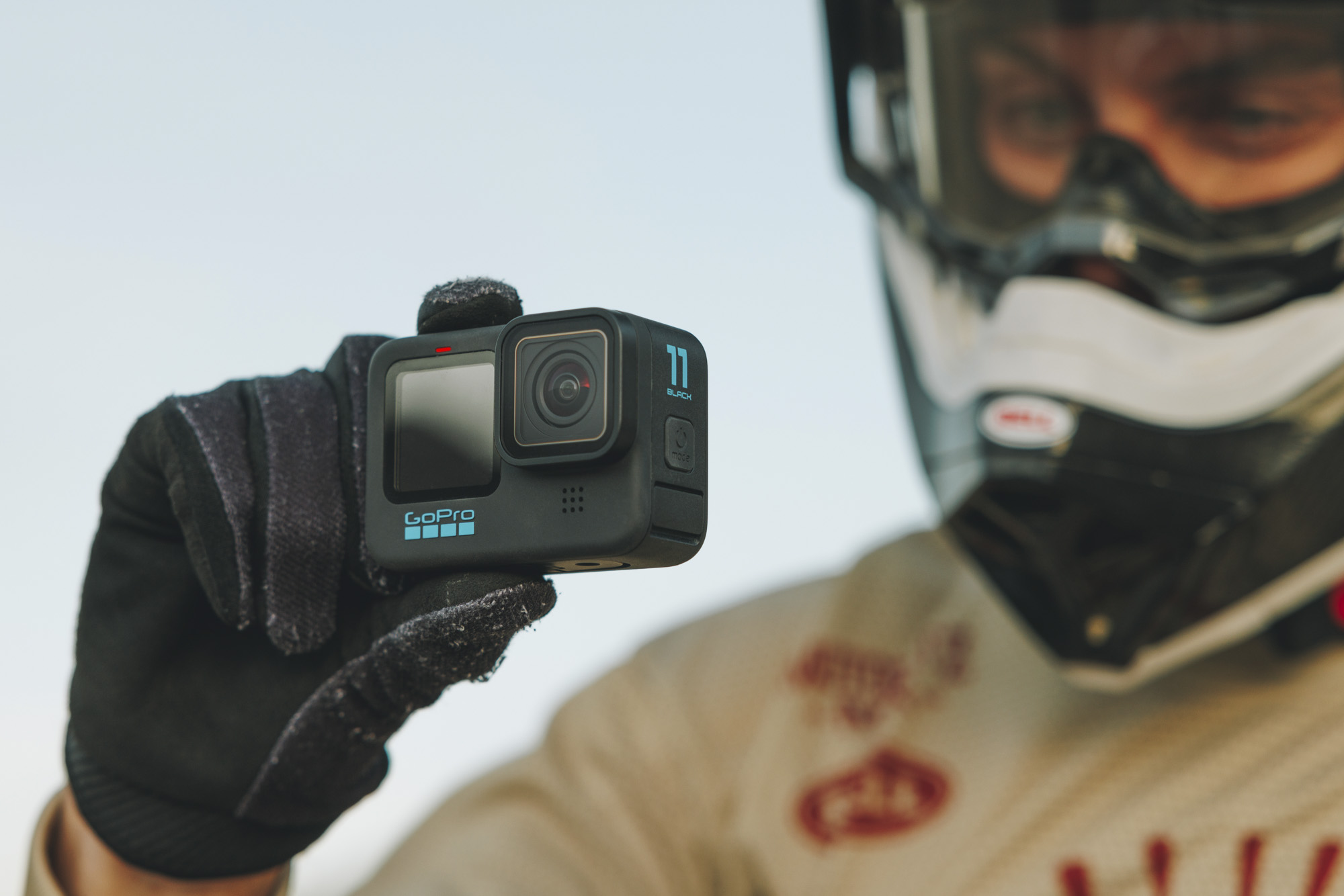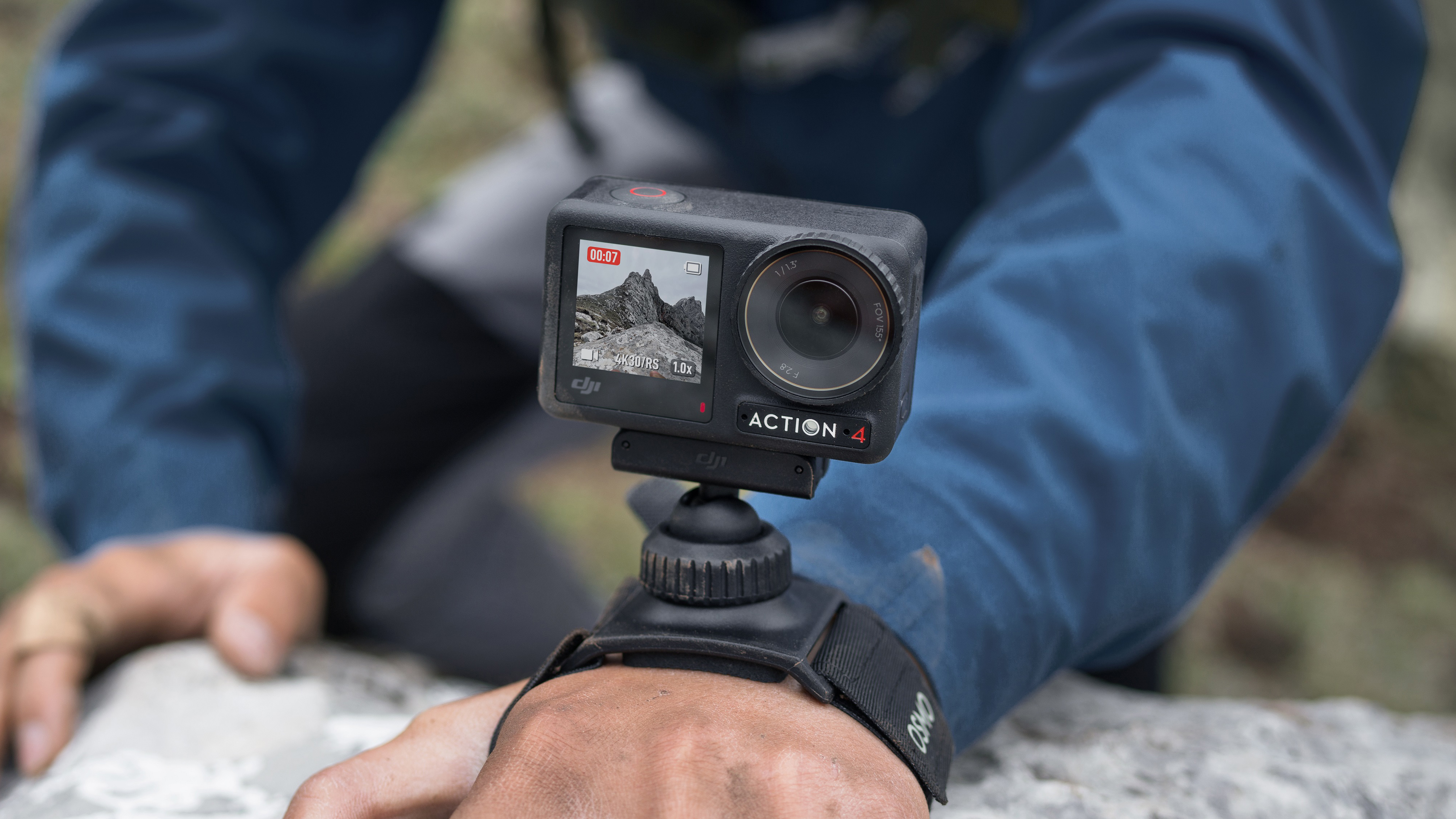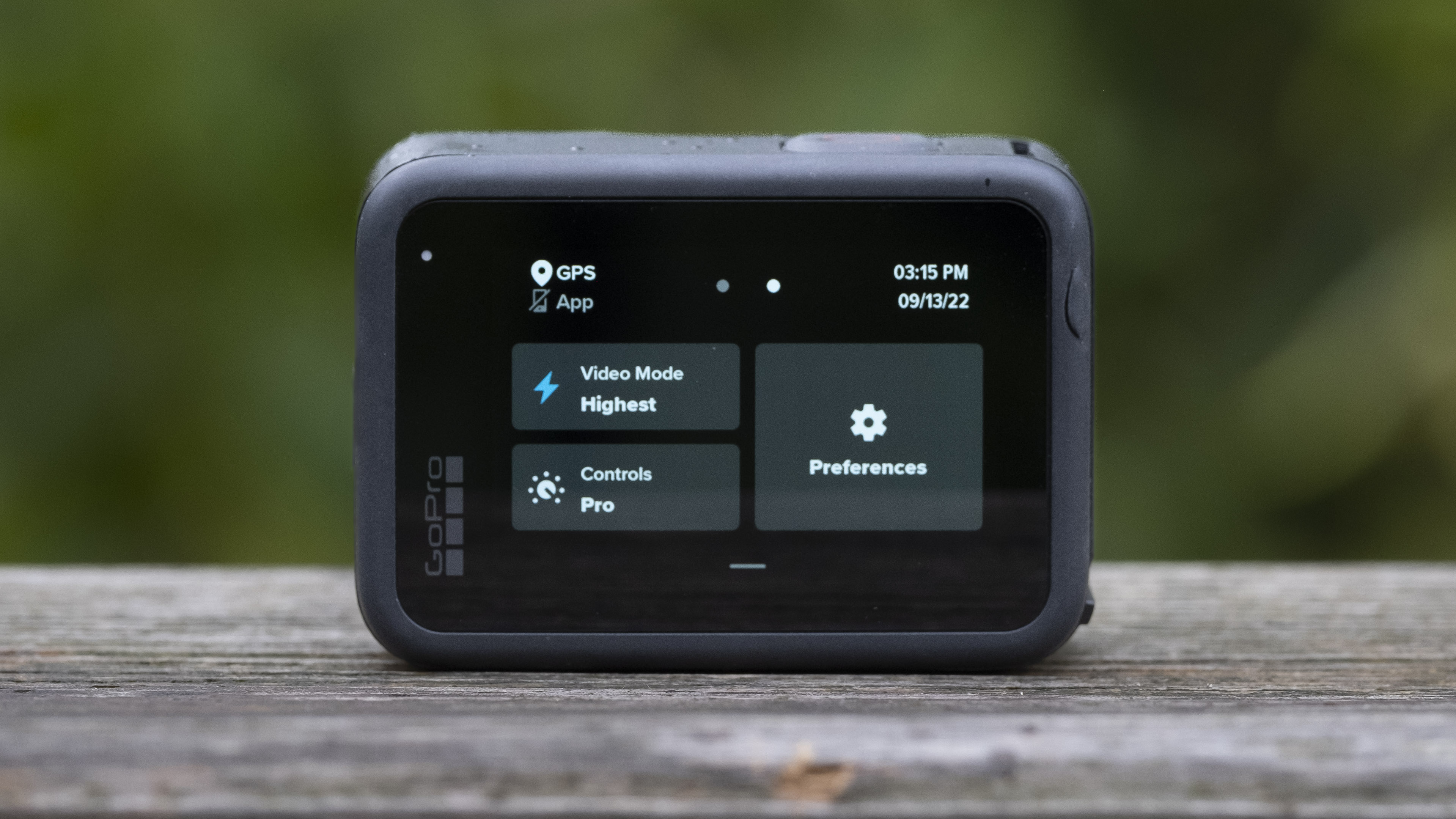
Feature-packed and ready for action, the GoPro Hero 11 Black makes it easy to shoot and crop sharp clips in all conditions.
For
- New sensor is ideal for vertical videos
- 10-bit mode a boon for color grading
- Superior Enduro battery now standard
Against
- Audio options still limited
- Still not great in low light
- Budget rivals offer better value
Identical to its predecessor, a bigger sensor inside could make the Osmo Action 4 a winner for low-light recording,
For
- Larger 1/1.3in sensor for improved low-light performance
- Support for D-Log M profile
- Deeper waterproofing
Against
- Pricier than previous model
- Same frame rates as before
When it comes to action cameras, GoPro has long been king of the hill. Not content with the status quo, though, drone maker DJI has been steadily closing the gap, releasing a string of capable Osmo Action models with the skills to challenge GoPro’s Hero line-up. Its latest effort is no exception. So how does the newly released DJI Osmo Action 4 stack up against the GoPro Hero Black?
It’s certainly in for some stiff competition: as per our GoPro Hero 11 Black review, we think GoPro's newest flagship is currently the best action camera you can buy. From remarkably effective Horizon Lock steadying to an 8:7 aspect ratio that makes it easy to crop your content for social, it’s a capable action cam that’s absolutely packed with features. And with a familiar form factor, including useful fold-out mounting fingers, it doesn’t change what already works.

Tackling such a stalwart of the genre will require something special, which is exactly what DJI has tried to deliver in the Osmo Action 4, installing a larger 1/1.3in sensor that’s designed to beat the Hero 11 Black in low-light scenarios. It’s also added 10-bit D-Log M support to give video editors more color depth to work with. Plus it can dive even deeper than before.
Is that enough to make the DJI Osmo Action 4 a genuine alternative to the GoPro Hero 11 Black? We won’t know for certain until our expert reviewers have fully tested the new challenger. But to help you make a buying decision in the meantime, we’ve compared the cameras spec-for-spec below, to assess exactly how the two rivals measure up on paper.
GoPro Hero 11 Black vs DJI Osmo Action 4: Price and availability
- GoPro Hero 11 Black: $399.99 / £399.99 / AU$649.95
- DJI Osmo Action 4: $399 / £379 / AU$629
Both the GoPro Hero 11 Black and the DJI Osmo Action 4 are available to buy now as standalone cameras, or bundled with a selection of official accessories.
GoPro is no longer offering discounts on the Hero 11 Black for GoPro subscribers. That means you’ll pay a flat rate for the action camera, whether or not you’re signed up.
The GoPro Hero 11 Black costs $399.99 / £399.99 / AU$649.95 for the camera alone. You can also buy it with an Accessories Bundle, which includes a spare Enduro battery, head strap and quick clip mounts, a camera case and GoPro’s floating Handler grip. This will set you back $449.99 / £449.99 / AU$729.95, which represents a solid saving compared to what you’d pay if you bought all of those separately.

Unlike the DJI Osmo Action 3, which significantly undercut the DJI Hero 11 Black in most markets, the DJI Osmo Action 4 is much closer in price to its GoPro rival. Priced at $399 / £379 / AU$629, the Standard Combo costs the same in the US as the Hero 11 Black. Besides the camera, it includes DJI’s Horizontal-Vertical Protective Frame case, plus a quick-release mount and adhesive base.
Those with bold plans for the Osmo Action 4 should find decent value in the Adventure Combo. Designed to power the camera through tougher shoots, it includes three Extreme batteries and a charging case, as well as a 1.5m selfie stick and everything that’s included with the Standard Combo. It’s priced at $499 / £469 / AU$819.
GoPro Hero 11 Black vs DJI Osmo Action 4: Sensors
- GoPro Hero 11 Black: 1/1.9-inch CMOS, 24.7MP stills
- DJI Osmo Action 4: 1/1.3-inch CMOS, 10MP stills
One of the headline features of the GoPro Hero 11 Black is the 8:7 aspect ratio of its sensor. Unlike the standard 4:3 format used by most action cameras, including the DJI Osmo Action 4, this taller, almost square setup is much more flexible when it comes to reframing for portrait and landscape.
It means you can export videos in a range of formats – such as 9:16 for TikTok and Instagram Stories – without sacrificing any resolution. That makes it the more versatile option if you plan on sharing your clips across different social platforms. Plus the new ratio has the added perk of unlocking a ‘HyperView’ digital lens, equivalent to a super-wide 12mm focal length.
DJI hasn’t published pixel numbers for the Osmo Action 4’s sensor, but based on the maximum stills resolutions of each action camera – 10MP for the Osmo and 27MP for the Hero 11 Black – it’s clear which one has the sharper sensor. In fact, it’s technically a step back for the DJI, versus the 12MP images that its predecessor could capture.

Where the Osmo Action 4 wins, though, is with the physical size of its sensor. At 1/1.9 inches, the GoPro Hero 11 Black’s sensor is relatively small. That’s borne out by its low-light performance, which remains one of the camera’s few drawbacks. In our hands-on test, we found that it still struggles in dim conditions, even with software working hard to limit noise and rescue detail.
In contrast, the DJI Osmo Action 4 ships with a 1/1.3-inch sensor. That’s significantly larger than both the GoPro’s and the 1/1.7-inch sensor in the DJI Osmo Action 3. Combined with the Action 4’s lower resolution, that means bigger pixel, which should translate into superior light gathering. Like the Hero 11 Black, it also employs a lens with a wide f/2.8 aperture, which should further help with detail after dark.
Our verdict on how this translates to real-world results will have to wait for our full review of the Osmo Action 4, but while the GoPro Hero 11 Black has the higher resolution, there’s plenty on paper to suggest that the Osmo has the upper hand when it comes to low-light performance. Helpfully for social sharing, it also supports native vertical recording with the bundled Protective Frame.
GoPro Hero 11 Black vs DJI Osmo Action 4: Video quality
- GoPro Hero 11 Black: 5.3K / 60p and 4K / 120p slow-mo
- DJI Osmo Action 4: 4K / 60p and 4K / 120p slow-mo
When it comes to frame rates and resolutions, nothing has changed between the two from when we compared the GoPro Hero 11 Black to the DJI Osmo Action 3. The former shoots sharper, with the option to record 5.3K video at 60fps with a 16:9 aspect ratio, or 5.3K/30p using the full sensor. Like the previous edition, the Osmo Action 4 tops out at 4K/60p using the full sensor.
Both cameras can record 4K slow-mo at 120fps with a 16:9 crop, but the GoPro also has the edge if you want faster frame rates: it can capture 240fps footage at 2.7K, while the Osmo Action 4 can only do so at a resolution of 1080p.

We previously commented that the GoPro Hero 11 Black had a wider dynamic range than the DJI Osmo Action 3, with a better ability to balance highlights and shadows. The HDR option has actually been removed from the Osmo Action 4, suggesting that the larger pixels on its new sensor have been used to improve dynamic range across all modes by default.
What’s certainly a step forward with the DJI Osmo Action 4 is the addition of a 10-bit D-Log M color mode. This brings it up to par with the GoPro Hero 11 Black, which already featured support for 10-bit video. This won’t dramatically improve video quality by default, but rather make it easier for video editors to tweak flat footage to bring out color depth in the resulting footage.
GoPro Hero 11 Black vs DJI Osmo Action 4: Build and durability
- GoPro Hero 11 Black: 154g, waterproof to 10m
- DJI Osmo Action 4: 145g, waterproof to 18m
Physically, the DJI Osmo Action 4 is all but identical to its predecessor, which means it has a form factor very similar to the GoPro Hero 11 Black. The Osmo measures 70.5 x 44. 2 x 32.8mm, while the Hero is marginally larger at 71.8 x 50.8 x 33.6mm. Weight wise, its 145g to 154g.
There’s a 2.25-inch touchscreen on the back of the Osmo, versus a 2.27-inch rear touch display on the Hero 11 Black – which is close enough to be functionally equal. Both cameras also feature 1.4-inch front screens for framing, but only on the Osmo is this touch-enabled. Whether this is useful will depend on how much you shoot with the camera facing you. For vloggers, the option to tap and swipe through settings from the front could be a difference maker.

Like the Osmo Action 3 before it, the DJI Osmo Action 4 also has the upper hand over the GoPro Hero 11 Black when it comes to waterproofing. While the GoPro is good down to 10 meters, the DJI can safely go to 18 meters (60 feet) without any additional housing. That’s the recreational limit for most open water divers, meaning the Osmo Action 4 could be the natural choice for water babies who want to record their undersea exploits. It’s worth noting that both models can be fitted with waterproof cases that increase their maximum depths to 60m (196ft).
As for other accessories, GoPro has the larger catalogue of compatible peripherals, although both manufacturers offer a wide range official add-ons for their action cameras. For mounting, the Hero 11 Black sticks with the fold-out fingers first seen on the Hero 8 Black. These work fine, but they do require you to screw and unscrew a mounting pin to swap attachments.
We much preferred the quick-release system of the Osmo Action 3 in our review. Using a combination of magnets and clamps, this allows you to switch peripherals without having to mess with any threads. The same system returns for the Osmo Action 4, which could give it continued appeal for those who like to hot-swap between mounts while recording their adventures.

GoPro Hero 11 Black vs DJI Osmo Action 4: Video stabilization
- GoPro Hero 11 Black: 360° Horizon Lock stabilization
- DJI Osmo Action 4: 360° HorizonSteady stabilization
In terms of video stabilization, the Hero 11 Black’s HyperSmooth 5.0 algorithm proved superlative in testing, setting a new benchmark for steadiness. On paper, DJI’s RockSteady 3.0/3.0+ system is the same for the Osmo Action 4 as it was for the Action 3. This previously proved very effective, if not quite a parallel to GoPro’s system – but only testing will determine how it stacks up now.
Also unchanged for the Osmo Action 4 are its HorizonSteady and HorizonBalancing smarts. Like Horizon Lock on the GoPro Hero 11 Black, the former keeps the horizon steady even as the camera rotates through 360 degrees. But GoPro beats DJI at its own game here: the Action 4 can only lock the horizon for footage up to 2.7K/60p, versus 5.3K/30p for the Hero 11 Black.

At higher resolutions, horizon levelling applies to counteract tilt up to a certain angle. The thresholds are 45 degrees for the Osmo and 37 degrees for the GoPro, although the limits vary for the Hero 11 Black based on which digital lens and frame rate you’re using.
But where the Hero 11 Black can level out 5.3K/60p and 4K/120p video, the DJI can only do so for video captured at 60fps in any resolution, up to its 4K maximum. So if you want the sharpest, steadiest video from an action camera, the GoPro Hero 11 Black still looks like the way to go.
GoPro Hero 11 Black vs DJI Osmo Action 4: Performance and features
- GoPro Hero 11 Black: 360-degree Horizon Lock stabilization
- DJI Osmo Action 4: 360-degree HorizonSteady stabilization
One area where GoPro’s Hero cameras have traditionally excelled over rivals is software, and the Hero 11 Black is certainly a feature-packed action camera. We found the icon-based interface intuitive to use in our hands-on Hero 11 Black review, with settings divided between a streamlined Easy mode and a Pro option with more advanced controls.
There’s no equivalent for the DJI Osmo Action 4, so beginners might find there’s more to get to grips with initially. That said, it does give you the option to save up to five settings presets, and swap between them using the Quick Switch shortcut button. Both cameras benefit from the usual timelapse modes, but even with its low-light focus, the Osmo has no answer to the GoPro’s Night Photo and Light Painting modes.

When it comes to the smartphone apps for each action camera, both the DJI Memo app and GoPro Quik app offer in-depth wireless control and editing options. But it’s Quik that’s the slicker of the two, particularly if you want clip compilations that are ready to share. Its automated edits produce highlight reels with minimal effort required.
As for longevity, DJI claims the Extreme battery included with the Osmo Action 4 is good for more than 2.5 hours, if you have Wi-Fi disabled. With a capacity of 1770mAh, it slightly outranks the 1720mAh Enduro battery that comes with the GoPro Hero 11 Black – although actual staying power will depend on a range of factors. The DJI battery is also rated to work at temperatures as low as -20C, which is colder than the -10C window quoted by GoPro.
Finally, we felt that on-board audio was average in our initial GoPro Hero 11 Black test. Though it uses a similar three-mic array, we actually preferred the sound output of the DJI Osmo Action 3, particularly for vlogging. Assuming the same setup works as well for its successor, it could give the Action 4 an edge. Then again, serious vloggers will likely pair their action camera with either the DJI Mic or GoPro’s Media Mod for cleaner audio.

Which one should I buy?
One of the biggest selling points of the DJI Osmo Action 3 was that it offered GoPro-like features for less cash than the Hero 11 Black. Its successor goes a different way. With prices increased such that the two cameras now essentially cost the same, the DJI Osmo Action 4 instead attempts to differentiate itself with a larger sensor that promises better abilities in an area where GoPro cameras have long struggled: low light.
It’s an approach we’ve seen before, from cameras like the Insta360 One R 1-inch edition, but the Action 4 tries to strike a better balance between price and performance. Until we’ve fully tested DJI’s new contender, we won’t be able to say how well it achieves this aim. But with its 1/1.3-inch sensor, we can see the Osmo Action 4 appealing to those who favor an action camera’s light-gathering abilities over outright resolution.
That said, on paper at least, the GoPro Hero 11 Black still looks likely to be the more rounded action camera package. For pretty much the same money as the DJI Osmo Action 4, it shoots sharper and slicker, with horizon locking available at higher resolutions and frame rates. It’s also the more versatile tool for exporting to social, courtesy of its 8:7 sensor, while its interface and associated apps are arguably slicker overall.
For outright value, the price parity means the choice between the Hero 11 Black and the Osmo Action 4 isn't clear cut. If you want a solid action camera with quick magnetic mounting, decent 4K recording specs and better waterproofing than the Hero 11 Black, we think the DJI Osmo Action 3 is probably still the best-value alternative – provided you’re happy to do without the larger sensor and 10-bit support offered by its successor.







